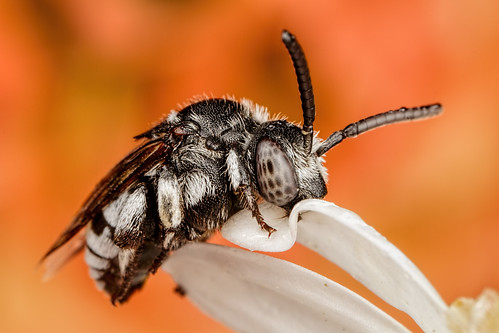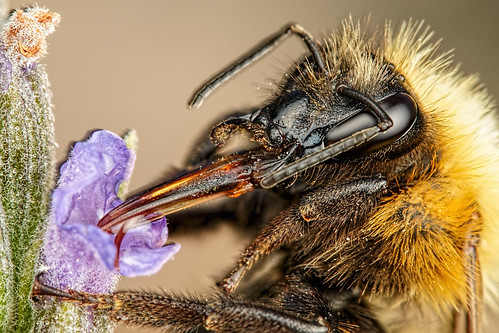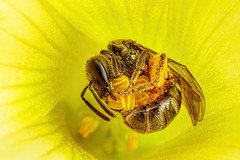
The problem though, at least for me, is that I don't like black backgrounds in my images and from the feedback I've received a lot of you don't either. I really don't care about making my images look "natural" because that word is just too subjective. Ask half a dozen people what natural means and you're likely to get six different answers. Add to that the fact that you can't "naturally" see the level of detail that I can show you, so by my definition macro photography isn't "natural" anyway. But I do want you to suspend disbelief and just enjoy the subject and how I'm presenting it to you. I don't want you to get hung up and distracted because the background is black. It's easy to have something in the background if I have control over a lethargic subject, or I can use the flower that it's on to reflect the light from the flash back into the camera. But the real trick is shooting a hyperactive subject in conditions where I have very little control, and when there isn't anything close to the critter that I can use for a background.
I get most of my inspiration from portrait photography, and one of the techniques that portrait photographers use it to set the camera at the ISO and Fstop that they want to use for the subject and then "drag the shutter" to expose for the background. Dragging the shutter simply means decreasing the shutter speed until you get the exposure that you want. So you basically use the shutter to control the amount of natural light that's coming into the lens to expose for the background, and then use the flash to expose the subject. But a portrait photographer is shooting scenes that are reflecting a lot more natural light back into the camera than what I can get in a macro photo. Since I was concerned about getting too close to the natural light exposure for the subject I set my flash to second curtain sync, so that the flash would be the last significant light source recorded by the sensor and if there was enough natural light to record movement I'd freeze the action at the end of it and still get some detail. If you look closely at this next image you can see how that movement looks in the trailing antenna of this bumblebee -look at the "shadow" above it.

There was a lot of hard sunlight reflected off of a white wall in my garden and at 1/30 of a second the shutter speed was too slow to stop the motion in the scene. The background is actually a sidewalk about two meters from the subject and I was trying to keep it from looking too dark.
For this next shot I set up a field studio, injected a Wall Flower with artificial nectar, and waited for a visitor. The flower is actually in the shade, and I'm shading the subject as well with the camera, and yet at 1/60 of a second there is still a little movement at the back part of the wing.

At first I thought that I might have caught the far wing, out of focus. But the more I look at the image the more I think it's actually just a motion artifact.
After a lot of trial and error, and in a wide range of lighting conditions, I've pretty much settled on 1/125 as being my minimum shutter speed when shooting critters that have antenna. With the camera set to F11, 1/125, and ISO 200 I'm getting scenes like this one with no recorded movement.

Under ideal conditions you want to be able to cast a hard shadow over the subject, and in an area where there isn't a lot of reflective light hitting it from the sides, so that if the flash didn't fire the subject and the area around it would be a silhouette. In the absence of natural light the short duration of the flash will allow you to freeze any subject motion. The "shadows" that I recorded are not the result of a decrease in the background exposure but are due to natural light striking the area that moved and bouncing back into the camera.
Also keep in mind that it's OK to under expose the background a little, as long as it's not completely black it won't be distracting. The 70D that I shoot with displays the exposure in the viewfinder (+/- 3 stops) and if I know I'll be shooting in a certain direction I'll take a look at the exposure in the view finder and adjust the shutter, ISO, and Fstop until I get to within -2 stops (under exposing the background actually causes the color in it to saturate). But I try to set the ISO no higher than 200 to avoid image noise, and the Fstop no lower than F11 so I can still get a decent amount of depth. Both of those decisions are based on my personal preferences and the ISO noise performance of my camera.
You'll have to do some experimenting since you might be shooting different subjects, and under different conditions than I am. But hopefully you can use this article as a guide to get you started. Until next time happy shooting! :)


No comments:
Post a Comment